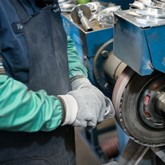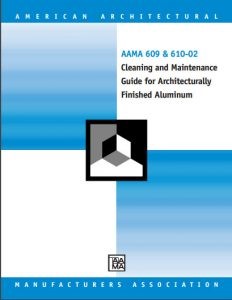| Mechanical Finishes |
| Type of Finish | AA Designation | Description | Examples of Methods of Finishing |
| As Fabricated | M10 | Unspecified | |
M11 | Specular, as fabricated | |
M12 | Nonspecular, as fabricated | |
M1X | Other | To be specified. |
| Buffed | M20 | Unspecified | |
M21 | Smooth Specular | Polished with aluminum oxide compound. Grits coarser than 320; final polishing with 320 grit using peripheral wheel speed of 6,000 fpm. Polishing followed by buffing using aluminum oxide buffing compound and peripheral wheel speed of 7,000 fpm. |
M22 | Specular | Buffed with aluminum oxide compound using peripheral wheel speed of 7,000 fpm. |
M2X | Other | To be specified. |
| Directional Textured | M30 | Unspecified | |
M31 | Fine Satin | Wheel or belt polished with aluminum oxide grit of 320 to 400 size; peripheral wheel speed of 6,000 fpm. |
M32 | Medium Satin | Wheel or belt polished with aluminum oxide grit of 180 to 220 size; peripheral wheel speed of 6,000 fpm. |
M33 | Coarse Satin | Wheel or belt polished with aluminum oxide grit of 80 to 100 size; peripheral wheel speed of 6,000 fpm. |
M34 | Hand-Rubbed | Hand-rubbed with stainless steel wool lubricated with neutral soap solution. Final rubbing with a No. 00 steel wool. |
M35 | Brushed | Several varieties of directional finish with parallel scratch lines may be produced by using power-driven stainless steel wire-wheel brushes, brushed-backed sander heads, abrasive-impregnated foam nylon discs or abrasive cloth wheels. |
M3X | Other | To be specified. |
| Non-Directional Textured | M40 | Unspecified | |
M41 | Extra-fine Matte | Air-blasted with finer than 200-mesh washed silica or aluminum oxide. Air pressure 45 lb. gun 8-12 in. at 90º angle. |
M42 | Fine Matte | Air-blasted with finer than 100- to 200-mesh silica sand if darkening is not a problem; otherwise aluminum oxide type abrasive. Air pressure 30 to 90 lb. (depending upon thickness of material); gun distance 1 foot from work at an angle of 60 º to 90º. |
M43 | Medium Matte | Air-blasted with finer than 40- to 50-mesh silica sand if darkening is not a problem; otherwise aluminum oxide type abrasive. Air pressure 30 to 90 lb. (depending upon the thickness of material); gun distance 1 foot from work at an angle of 60º to 90º. |
M44 | Coarse Matte | Air-blasted with finer than 16- to 20-mesh silica sand if darkening is not a problem; otherwise aluminum oxide type abrasive. Air pressure 30 to 90 lb. (depending upon the thickness of material); gun distance 1 foot from work at an angle of 60º to 90º. |
| Chemical Finishes |
| Type of Finish | AA Designation | Description | Examples of Methods of Finishing |
Nonetched
Cleaned | C10 | Unspecified | |
C11 | Degreased | Organic solvent treated. |
C12 | Inhibited-chemical cleaned | Inhibited chemical type cleaner used. |
C1X | Other | To be specified. |
| Etched | C20 | Unspecified | |
C21 | Fine Matte | Trisodium phosphate, 3-6 oz. per gallon used at 140-160 ºF for 3 to 5 minutes. |
C22 | Medium Matte | Sodium hydroxide, 4-6 oz. per gallon used at 140-150 ºF for 5 minutes. |
C23 | Coarse Matte | Sodium fluoride, 1-1/2 oz., plus sodium hydroxide, 4-6 oz. per gallon used at 140-150 ºF for 5 minutes. |
C2X | Other | To be specified. |
| Brightened | C30 | Unspecified | |
C31 | Highly Specular | Chemical bright dip solution of the proprietary phosphoric-nitric acid type used, or proprietary electrobrightening or electropolishing treatment. |
C32 | Diffuse bright | Etched finish C22 followed by brightened finish C31. |
C3X | Other | To be specified. |
| Anodic Coatings |
| Type of Finish | AA Designation | Description | Examples of Methods of Finishing |
| Protective & Decorative (coatings less than 0.4 mil thick) | A21 | Clear (natural) coating | Coating thickness to be specified, 15% H2SO4, used at 70ºF +/- 2ºF, at 12 amp per sq. ft. |
A22 | Coating with integral color | Coating thickness to be specified. Color is dependent on alloy and processing methods. |
A23 | Coating with impregnated color | Coating thickness to be specified, 15% H2SO4, used at 70ºF +/- 2ºF, at 12 amp per sq. ft. followed by dyeing with organic or inorganic colors. |
A2X | Other | To be specified. |
| Architectural Class 11 (0.4 to 0.7 mil coating) | A31 | Clear (natural) coating | 15% H2SO4, used at 70ºF +/- 2ºF, at 12 amp per sq. ft. for 30 minutes, or equivalent. |
A32 | Coating with integral color | Color is dependent on alloy and anodic process. |
A33 | Coating with impregnated color | 15% H2SO4, used at 70ºF +/- 2ºF, at 12 amp per sq. ft. for 30 minutes, or equivalent followed by dyeing with organic or inorganic colors. |
A3X | Other | To be specified. |
| Architectural Class 1 (0.7 mil and greater anodic coating) | A41 | Clear (natural) coating | 15% H2SO4, used at 70ºF +/- 2ºF, at 12 amp per sq. ft. for 60 minutes, or equivalent. |
A42 | Coating with integral color | Color is dependent on alloy and anodic process. May include Duranodic and certain architectural colors. |
A43 | Coating with impregnated color | 15% H2SO4, used at 70ºF +/- 2ºF, at 12 amp per sq. ft. for 60 minutes, or equivalent followed by dyeing with organic or inorganic colors. |
A4X | Other | To be specified. |


